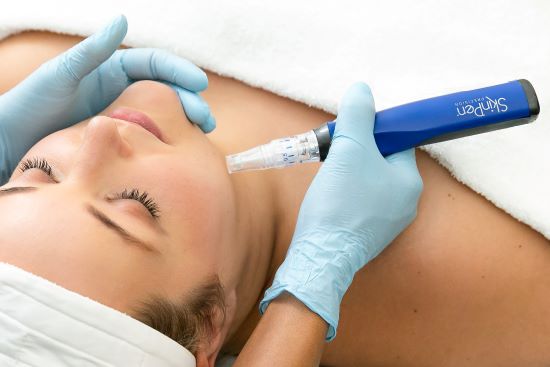Why You Should Consider Microneedling: 7 Different Treatment Options Explained

What is Microneedling?
Microneedling is a minimally invasive skincare treatment that uses tiny, sterile needles to create controlled micro-injuries on the skin. This stimulates the body’s natural healing response, triggering collagen production and promoting skin regeneration.
Dermarolling vs. Microneedling: What’s the Difference?
While both dermarolling and microneedling involve the use of needles to improve skin appearance, dermarolling is a more superficial modality.
Dermarolling is typically an at-home procedure using a handheld roller with reusable needles. The needle depth is shallow, making it ideal for improving product absorption rather than addressing specific skin concerns. It’s important to regularly sterilize a dermaroller as they do carry a risk of infection when not cleaned properly.
In contrast, microneedling is performed in a professional setting using a device with adjustable needle depths. This deeper penetration helps target various skin concerns, from acne scars to fine lines, with more noticeable and long-lasting results.
7 Treatment Options with Microneedling
- Acne Scarring: Inflamed acne lesions often leave depressions in the skin as they heal. Microneedling helps rebuild collagen in these areas, reducing the visibility of scars and improving skin texture.
- Smokers’ Lines: Whether caused by smoking, straw use, or genetics, fine lines around the mouth can be smoothed out with microneedling by stimulating collagen production in the affected areas.
- Pore Size: Microneedling encourages collagen formation, which can tighten and firm the skin, making large pores appear smaller over time.
- Stretch Marks: Both genetic and trauma-related stretch marks can be improved with microneedling. The procedure stimulates the skin’s natural healing process, helping to smooth and reduce the appearance of stretch marks.
- Uneven Skin Texture: Microneedling promotes the production of collagen and elastin, which helps create smoother, more even skin texture.
- Collagen Stimulation: As we age, collagen production naturally declines, leading to fine lines and wrinkles. Microneedling triggers a healing response that stimulates collagen production, helping to maintain youthful, healthy-looking skin on the face and neck.
- Surgical Scars: Post-surgical scars can often be textured or depressed. Microneedling helps to smooth these scars by and promotes skin repair, making them less noticeable over time.
What’s The Process? Is There Downtime?
Microneedling begins with the application of a topical numbing cream, which stays on for about 20 minutes. Once the skin is numb it is cleansed and prepped for the treatment. A hyaluronic acid serum is applied to serve as a glide for the microneedling pen. The depth of the needles is adjusted based on the treatment area and skin concern.
The procedure itself feels like a warm, prickly sensation, with some areas potentially feeling ticklish – some patients even feel the urge to sneeze! As the treatment progresses tiny pinpoint bleeding will occur.
After the treatment your skin will appear deep pink/red. This redness will gradually lessen over the course of the day. The morning after treatment, your skin will still be pink and may feel tight and dry, which typically subsides within a few days. Mild flaking is common during the healing process.
If you are interested in microneedling in the Raleigh, Durham, Chapel Hill area, contact our office for more information on treatment.
